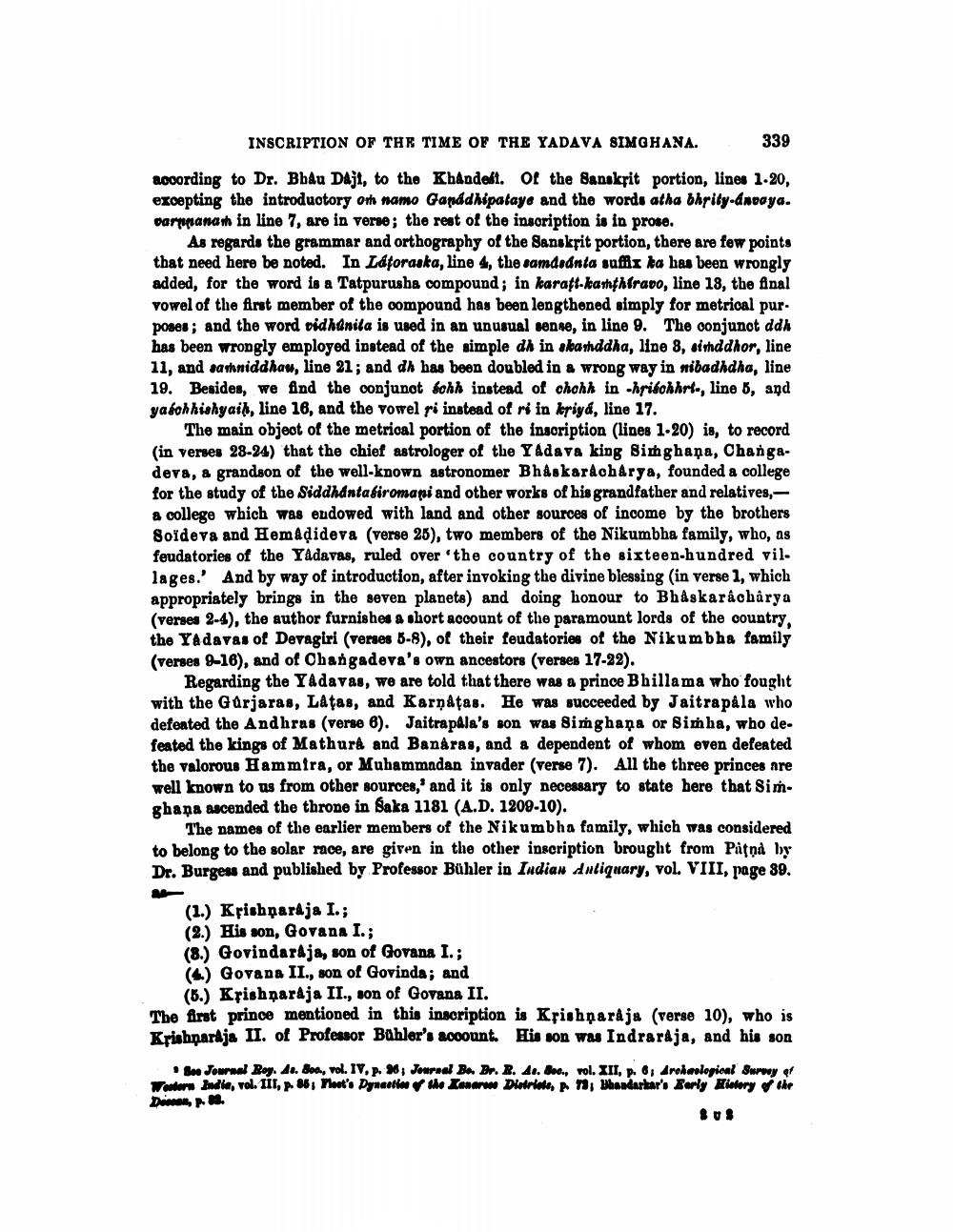________________
INSCRIPTION OF THE TIME OF THE YADAVA SIMGHANA.
339
according to Dr. Bhau Dajt, to the Khandelt. Of the Sanskrit portion, lines 1.20, excepting the introductory orh namo Ganddhipalayo and the words atha bhrity.dnvaya. barnpanam in line 7, are in verse; the rest of the inscription is in prose.
As regards the grammar and orthography of the Sanskrit portion, there are few points that need here be noted. In Laforaska, line 4, the samdodnta sufis ka has been wrongly added, for the word is a Tatpurusha compound; in karaft-kashfhfraco, line 18, the final vowel of the first member of the compound has been lengthened simply for metrical pur. Poses; and the word vidhanita is used in an unusual senne, in line 9. The conjunot ddh has been wrongly employed instead of the simple dh in alarddha, line 8, sind dhor, line 11, and sashniddhaw, line 21; and dh has been doubled in a wrong way in nibadhdha, line 19. Besides, we find the conjunot sohh instead of chohh in hribohhri., line 6, and yasohhishyail, line 16, and the vowel ri instead of ri in kriyd, line 17.
The main object of the metrical portion of the inscription (lines 1-20) is, to record (in verses 28-24) that the chief astrologer of the Yadava king Simghana, Changadeva, a grandson of the well-known astronomer Bhaskaracharya, founded a college for the study of the Siddhantasiromapi and other works of his grandfather and relatives, & college which was eudowed with land and other sources of income by the brothers Soïdeva and Hemadideva (verse 25), two members of the Nikumbha family, who, as feudatories of the Yadavas, ruled over the country of the sixteen-hundred vil. lages.' And by way of introduction, after invoking the divine blessing (in verse 1, which appropriately brings in the seven planets) and doing honour to Bhaskaracharya (verses 2-4), the author furnished a short account of the paramount lords of the country, the Yadavas of Devagiri (verses -8), of their feudatories of the Nikumbha family (verses 9-16), and of Ohangadeva's own ancestors (verses 17-22).
Regarding the Yadavas, we are told that there was a prince Bhilla ma who fought with the Gurjaras, Latas, and Karnatas. He was succeeded by Jaitrapala who defeated the Andhras (verse 6). Jaitrapala's son was simghana or Simha, who de. feated the kings of Mathura and Banaras, and a dependent of whom even defeated the valorous Hammira, or Muhammadan invader (verse 7). All the three princes are well known to us from other sources, and it is only necessary to state here that simghana ascended the throne in Saka 1181 (A.D. 1209-10).
The names of the earlier members of the Nikumbha family, which was considered to belong to the solar race, are given in the other inscription brought from Påtņå by Dr. Burgess and published by Professor Bühler in Indian duliquary, vol. VIII, page 89.
(1.) Kfishṇaraja I.; (2.) His son, Govana I.; (8.) Govindaraja, son of Govana I.; (4) Govana II., son of Govinda; and
(8.) Krishnaraja II., son of Govana II. The first prince mentioned in this inscription is Krishnaraja (verse 10), who is Krishnarja II. of Professor Bahler's account. His son was Indraraja, and his son
Sve Journal Roy. dr. Son, vol. IV. p. * Joursel Be. Dr. B. 41. doc., vol. XII, p. 6, Aromlogical Survey er worn India, vol. III, p. 86, Moet's Dynastiat e Lanar. Dietrite, na handarkar'. Early History the Doce, p.




